-
Venus has had a long history.
- the NASA Magellan spacecraft
(1989--1994)
that
did radar mapping
of the whole Venus surface.
- the
Soviet Venera spacecraft (1961--1985)
which included
landers.
The successful landers
penetrated the
Venusian atmosphere and landed
on the Venusian surface.
They survived only a few hours at most because of
the extreme heat and pressure they were subjected to.
At least when at its brightest, it is the 3rd brightest astro-body coming in after the Sun and the Moon.
Because it is an inner planet it is always close to the Sun in the sky: maximum elongation is about 46 degrees (Ze2002-15).
Thus, it is a morning and evening star: in fact THE Morning Star and Evening Star of history. See the Venus as the Morning Star of Evening Star in the figure below (local link / general link: venus_sunset.html).
Mercury is also a morning and evening star, but it is NOT nearly as noticeable.
Remember the ancient point of view in which the sky is
a giant dome over the flat Earth:
see the figure below
(local link /
general link: babylonian_cosmos.html).
In the figure,
the crescent moon is
east of the Sun, and so is most visible
after the Sun has set in the west.
Question: When is Venus an evening star?
Venus is also the
unearthly planet that comes closest to us.
Answer 2 is right.
But from Earth-based telescopes in the visible, Venus is almost a featureless yellowish-white (HI-170).
What we are seeing is the highly reflective cloud cover that totally covers Venus.
Only with using other frequency bands to study Venus and sending spacecraft to orbit and land on Venus has Venus' nature elucidated somewhat.
The most important spacecraft till 2022 are:
- Tabulated Facts:
See below Table: Venus Facts
______________________________________________________________________________ Table: Venus Facts ______________________________________________________________________________ Quantity Value _______________________________________________________________________________ Venus symbol ♀ : Also the female gender symbol Mean distance from the Sun 0.7233 astronomical units Eccentricity of orbit 0.0068 : which is the smallest planetary eccentricity: i.e., the orbit is the most circular. Axis tilt to orbital pole 2.7°: which is very small. Venus probably has almost NO seasons because of this and the small eccentricity. Mean inclination to Ecliptic 3.39471° Orbital period 224.701 days Rotational Period 243.0226 days : and it is a retrograde rotation (i.e., clockwise looking down from the north ecliptic pole). Venusian day 116.750 days and it is a retrograde rotation Equatorial radius 6052 km ≅ 0.95 R_Earth_equatorial Mass 4.870*10**24 kg ≅ 0.815 Earth masses Mean density 5.24 g/cm**3 = a bit less than mean Earth density Uncompressed mean density 4.2 g/cm**3 ≅ uncompressed mean Earth density, a model-dependent result Surface gravity 0.903 Earth gravities Surface temperature ∼ 470 C ≅ 740 K all the time : it's hot _________________________________________________________________________
References: Cox-294,295, Se-418,467, HI-169, Wikipedia: Venus.
_________________________________________________________________________
-
Question: Given the very small axis tilt of Venus and
very small eccentricity of Venus' orbit,
one would expect
Venus
to have:
- extreme seasons.
- almost no seasons.
- seasons with variations similar to those of the Earth.
Answer 2 is right.Every day (and they are very long days too: 116.750 days) is much like any other day on Venus weatherwise.
-
"Every day is like another"---from the
song of the Red Sheep
of El Dorado
in the
Candide (1956).
The total temperature variation may only be about 10 K from hot to cold regions (Ze2002-184). We discuss why below.
- Venusian Orbit, Axial Rotation, and Day:
Venus is unusual for a planet in having an axial rotation period of 243.0187 days (relative to the observable universe, of course) longer than its year (224.695 days).
Also unusually, its axial rotation is retrograde: i.e., it rotates westward or clockwise looking down from the north celestial pole (NCP).
These unusual rotation characteristics violate the trends that we believe the protoplanetary disk set up.
-
Question: What is the favored explanation of the
unusual rotation characteristics?
- An unusual tidal locking effect of the Sun.
- A gravitational perturbation by Earth.
- A giant impactor in the early Solar System that gave Venus a random rotational period and rotation direction.
Well answer 3 seems to be favored one, but answer 1 is also considered. Answer 2 seems ruled out. See Wikipedia: Venus: Orbit and rotation.- Transits of Venus:
Venus transits (i.e., the passage of Venus across the face of Sun: i.e., the solar photosphere) and their history are explicated a bit in the figure below (local link / general link: venus_transit.html).
Just some basic Venus facts---which, of course, beg for an explanation---and there is some explanation, but also some "Just So."
-
At the surface, pressure is about 90 atmospheres, the temperature is
about 740 K (470 C), and the composition is 96 % CO_2.
- very starry.
- illuminated by Venus' moon.
- pretty dark.
- Yes.
- No.
- Maybe.
-
It is claimed that the atmospheric density is so high, you
could strap on wings and fly on Venus
(Se-468).
Actually, the density is about 1/10 of water, and so the buoyancy force
is only about 1/10 of water's. So you won't float. Presumably
the flying claim is based on changed aerodynamic lift and drag
and NOT buoyancy.
This causes Venus' surface temperature to be 740 K (or 470 C) which is hotter than Mercury's mid-day temperature of about 600 K.
Also Venus' surface temperature is pretty constant with location and time of day for reasons will go into below.
_______________________________________________________________________
Table: Venusian Atmospheric Composition by Number
_______________________________________________________________________
Gas Percentage
(%)
_______________________________________________________________________
CO_2 96.5
N_2 3.5
SO_2 0.015
water vapor
sulfuric acid (H_2SO_4)
hydrochloric acid (HCl)
hydrofluoric acid (HF)
and other stuff <0.03
______________________________________________________________________
References: HI-171;
CW-35;
Se-467.
______________________________________________________________________
The Venusian atmosphere is explicated in the figure below (local link / general link: venusian_atmosphere_layers.html).
I think there might be sometimes lightning on Venus, but I can't
find where I noticed that.
Occasionally, a volcanic eruption might provide some illumination.
Of course, we are discussing the visible: in the infrared, the
Venus surface is probably quite bright compared to
Earth because
of high blackbody-like emission.
Answer 2 is right.
The ground is NOT quite red hot it seems, but it is close.
Apparently, to be red hot to the eye the temperature has to be
above 500 C or 770 K
(The Physics Factbook).
The Venus surface temperature is
just a bit low at 470 C or 740 K. But I wonder if it might NOT
appear just slightly reddish under dark conditions.
Question: Night skys on Venus would be:
Answer 3 is right. Remember night is about 58.375 days long.
Question: Is the Venusian ground glowing because it is red hot?
A bit of the surface of Venus is
shown in the figure below.
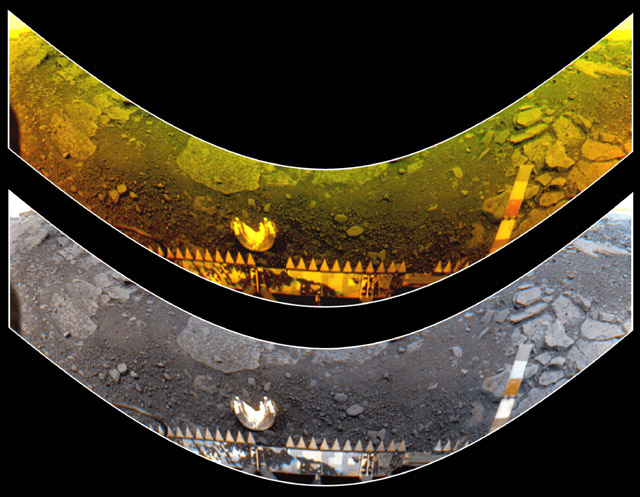
Caption: A Venera 13 lander image of the Venus surface, 1982 Mar01.
The Venera 13 survived only 2 hr, 7 minutes in the hot, high pressure conditions on Venus.
Part of the lander and a camera lens are at the bottom of the picture.
Flat rocks and soil are visible.
The rock seems to be similar to terrestrial basalt (i.e., dark, denser silicates rich in magnesium and iron probably formed from rapid cooling of lava probably on the surface).
The top image is true color to the Venusian atmosphere where blue light is filtered out. The bottom image is an attempt to correct the image to Earth lighting.
The lander's colored bar (seen in the image) had a known color scheme and that allowed the correction to Earth lighting.
For some reason, the Soviets always pointed their cameras at the ground, and so there are no actual Venus PANORAMAS as far as I know.
There is a bit of horizon at the edges of their broad images.
Probably, technical limitations forced them to use a fixed camera angle.
There are modeled panoramas based on radar mapping as we will see below.
Credit/Permission: Soviet space program,
Venera 13 (1981--1982),
1982 /
Public domain.
Download site: Views of the
Solar System by Calvin J. Hamilton.
CJH states that the image is
Public domain.
Image link: Itself.
Form groups of 2 or 3---NOT more---and tackle
Homework 13
problems 2--6 on
Venus facts and
the Venusian atmosphere.
Discuss each problem and come to a group answer.
Let's work for 5 or so minutes.
The winners get chocolates.
See Solutions 13.
End group activity period or
End group activity period or
End group activity period.
Group Activity:
-
Venus, of course, tends to be hotter than the
Earth because it is
closer to the Sun.
- The water vapor on Venus today if converted to liquid would
cover a perfectly round Venus to a depth of only 0.3 m.
- The original water content has been estimated to be
equivalent to a covering of 25 m from isotopic analysis.
- Earth's water covering a perfectly
round Earth would give
a 3000 m depth ocean (Se-468).
Science fiction writers once speculated that the high reflectivity of the Venusian clouds might keep the surface from being super-hot. They envisioned a perpetual rain on a swampy Venus inhabited by swamp creatures: e.g., Ray Bradbury in The Illustrated Man.
Recall NOT a lot of sunlight of does get to the surface: only about 3 % (Ze2002-184) which is a lot less than the 40 % of the sunlight that gets to the Earth's surface (Ze2002-157).
But the runaway greenhouse effect caused by the dense CO_2 atmosphere still makes the surface super-hot: about 740 K (470 C) which is hot enough to melt lead and tin (CAC-52).
-
Could there be ponds of lead and tin? Probably NOT. Any surface
amounts would probably seep into the hot soft rock---just guessing.
The closeness to the Sun was the key factor that set Venus on the road to perdition.
After Venus formed and cooled enough to hold any kind of an atmosphere, volcanic outgassing (see figure below: local link / general link: volcanic_outgassing.html) probably gave it a mainly CO_2 and water vapor atmosphere that may have been much like Earth's early atmosphere.
But Venus was just too hot for liquid water either ever or for
retaining it if it ever existed.
The water vapor in fact was largely lost. Convection probably carried it to high altitudes where UV sunlight broke it up and the hydrogen escaped.
-
Recall CO_2 dissolves in liquid water and in a slow process gets
broken up and helps to form CARBONATE ROCK, particularly calcium
carbonate (CaCO_3). This process is the quasi-ultimate CO_2
sink on Earth.
Volcanic outgassing
liberates some of the carbon plus other carbon as CO_2 again.????
The outgassing of CO_2 continued creating the super-CO_2 atmosphere of today and the runaway greenhouse effect.
The extreme heat of the surface baked sulfur, chlorine, and fluorine out of the ground, and so gave rise to vapors of sulfuric acid (H_2SO_4), hydrochloric acid (HCl), and hydrofluoric acid (HF).
Volcanoes are also probably injecting sulfur compounds into the atmosphere (FK-251).
-
Well it's NOT fully understood.
- Venus' magnetic field equilibrates the temperatures effectively.
- Global circulation due to convection in the atmosphere rapidly equilibrates the temperatures.
- We have no idea.
- The slow western rotation of Venus does impose an overall western flow pattern.
- A giant impactor.
The high altitude weather at the cloud layers is best known because we can see it and probes have gone down through it.
But what we do know about the surface is that the temperature is extremely uniform from equator to poles and from day to night side.
The total variation may only be about 10 K from hot to cold regions (Ze2002-184).
Now the Moon and Mercury are slow rotators with days of 29.5 and 176 Earth days, respectively. They both show extreme daily variations in temperature: i.e., 300 K for the Moon and 500 K for Mercury.
-
Question: Venus has a long day
of 116.75 days.
Why doesn't Venus have a large daily temperature variation?
Answer 2 is right. Remember the Moon and Mercury are virtually airless.
The pattern is best described as two giant VORTICES that are centered on the poles with jet stream winds of up to of order 300 km/hr always moving west mainly at the cloud layer.
-
West is clockwise as seen from the NCP.
The vortices split at the equator and spiral to the poles. They make a distinctive Y pattern (Se-467--468; FK-250). See the figure below.
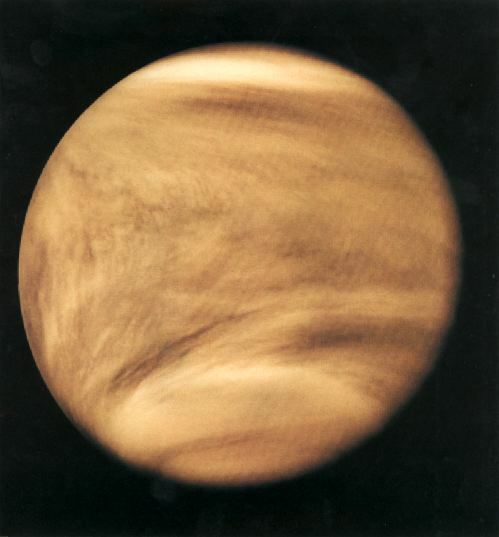
Caption: "Ultraviolet image of Venus clouds as seen by the Pioneer Venus Orbiter (Feb. 5, 1979)."
This is false color, of course. The pattern is NOT at all as distinct in the visible.
The clouds are at 50--70 km in altitude and are moving west at speeds of up to of order 300 km/hr The whole atmosphere seems to rotate with a period of about 4 days.
The pattern is of two vortices that split at the equator and spiral to the pole.
The Y pattern of the clouds is clearly seen.
Credit/Permission: NASA,
1979 /
Public domain.
Download site: NASA:
NSSDCA Photo Gallery Venus.
Image link: Itself.
The atmosphere is heated on the day side most intensely near the equator.
The hot air convects to the poles and night side at relatively high altitudes.
But somehow the pattern is two symmetric western spirals that are mirrored about the equator, and NOT an axially symmetric flow around the Sun-Venus line---which is the counterfactual case illustrated in the figure below (local link / general link: venusian_atmosphere_convection_false.html).
In this case it is a giant impactor is NOT to blame.
Question: Why does Venus NOT have
the counterfactual
axially symmetric flow with one giant convection cell
shown in the figure above
(local link /
general link: venusian_atmosphere_convection_false.html).
The slow rotation does somehow impose a western pattern wind pattern
and gives rise to two convection cells: a northern hemisphere
one and a southern hemisphere one
(FK-250).
Answer 1 is right.
The air rises and the equator and swirls westward to the poles where it sinks flows back in a westward??? swirl to the equator. The westward flow distributes the heat to the night side of Venus.
The circulation flow is in the main cloud layer where one has the high speed winds of 350 km/hr. The air flows around Venus in about 4 days (FK-250).
-
The actual pattern is a bit more complex since the
circulation cells are actually double cells: one below
and one above the main cloud layer
(FK-250)????.
And it seems that the slow rotation causes Venus to NOT exhibit local cyclones and anticyclones that make Earth's weather so unpredictable and variable (Se-468).
Turbulence with vortices occurs in fluids when one trys to change fluid speeds too quickly. For examples of vortices on Earth, see the figure below (local link / general link: earth_blue_marble.html).
The Venus cloud pattern pretty much looks the same all the time.
As far as we can tell Venus does NOT have much weather variation. Recall it has little seasonal variation.
On Venus probably every Venusian day of 116.75 days (retrograde is probably much like any other.
We know less about the surface winds on Venus, but they are much slower than the cloud layer winds it seems on average: maybe about 1 m/s or 4 km/hr (CW-37).
Remember the surface air is awfully dense (or of order 1/10 of water), and so has a lot of inertia (i.e., resistance to acceleration).
-
Thanks to the radar mapping
of the Magellan probe and earlier orbiters
(see Wikipedia: Venus: Radar mapping),
we know a lot about
Venusian geology---but still far less than there is to know.
- Venus is a planet and all planets are much alike.
- Venus is a rocky planet with about the same size and density
as Earth.
It formed relatively near Earth
in the Solar System,
and so should have about the same composition of
refractories.
- There is the granitic rock which together with
the terras suggests continents.
- Some trenches resembling oceanic trenches have been found in
the lowlands
(HI-175).
- There are some fold-mountains in the Ishtar terra
(Se-471).
This indicates some horizontal crustal motion, but that mountain
range is NOT large.
There are no large arcs of fold mountains that often indicate plate boundaries on Earth???.
- There seems to be a rift in the Aphrodite terra
(CW-37) perhaps indicating
a divergent boundary.
- The terras
cover a distinctly smaller fraction of Venus than the continental
crust does on Earth.
The terras cover about 24 % of Venus
and continental crust covers about 41 % of Earth
(HI-175;
Cox-253).
-
Question: If the water surface of the Earth
covers about 71 %
of the surface, how come the continental crust covers 41 % of the
surface?
- Bad math.
- Some of the water surface is under the continents.
- Some continental crust is submerged.
Answer 3 is right.Remember the continental shelves extend well beyond the coasts.
Of course, we have NO SEISMOLOGY. The Soviet VENERA LANDERS only survived a few hours on the surface at most: no time to wait for earthquakes even if they had seismometers.
We have no Venus rocks, but the VENERA LANDERS did take some pictures and did some crude analysis.
Although the atmosphere of Venus is radically different than Earth's we might expect the geology to be somewhat similar with the vast exceptions of NO water erosion and weathering and NO sedimentation.
-
Question Why should Venusian geology
be similar (except for
the vast exceptions)?
Answer 2 is right---even though it is a wrong supposition.
Should is NOT the same as is.
To investigate PLATE TECTONICS, we will first consider some Magellan mosaic radar images of Venus. See the figure below.
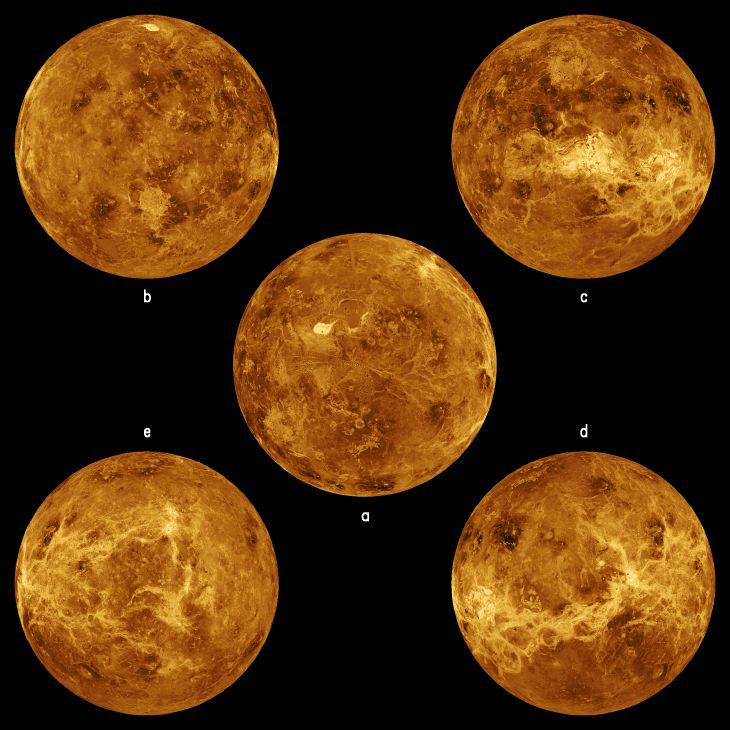
Caption: Five hemisphere views from Magellan radar maps.
Lava flows and faults appear as bright in the image.
Radar mapping is sensitive to the roughness of terrain and relatively younger lava is rougher than older material. This is how lava flows have been distinguished (Se-470).
Map a is centered on the north pole. Maxwell Montes is the bright region near the center: it is the highest mountain range on Venus.
The other maps are centered on the equator.
Map b at 0 longtitude.
Map c at 90 longtitude.
Map c at 180 longtitude.
Map d at 270 longtitude.
The color is false, of course, but was chosen to emphasize structural detail and simulate the colors seen on the surface by the Soviet Venera landers (1961--1985).
The scattered dark patches are halos surrounding the youngest impact craters. A study of the impact craters shows that Venus' surface is probably 500 to 800 Myr old (HI-177). (The time scales vary with reference source.)
Credit/Permission: NASA,
1995 /
Public domain.
Download site:
NASA:
NSSDCA Photo Gallery Venus . See
NASA Caption.
Image link: Itself.
Now the radar mosaics are cute, but how about a TOPOGRAPHICAL ELEVATION MAP. See the figure below.
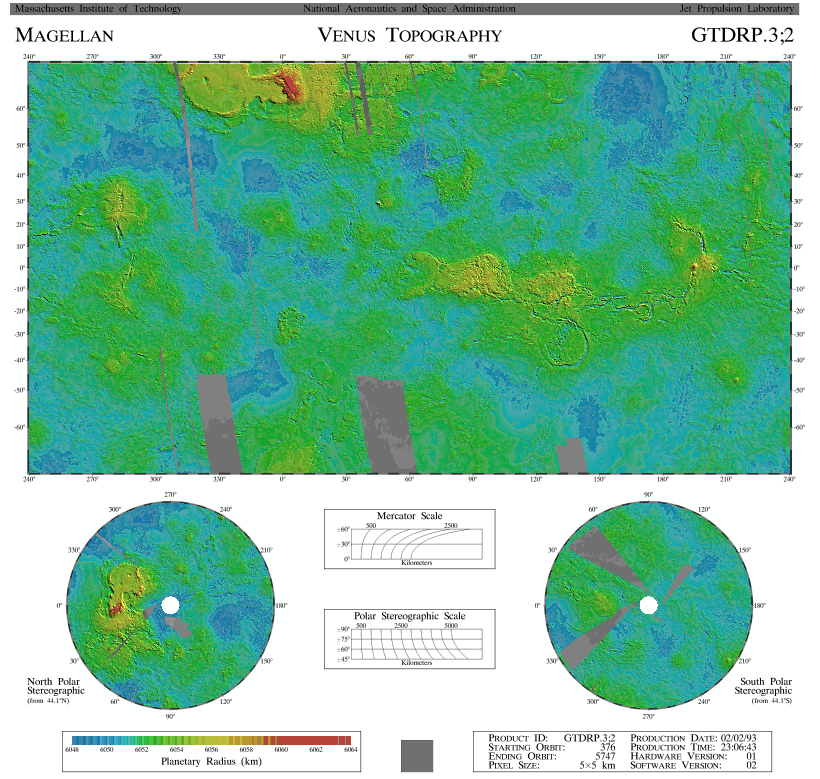
Caption: Venus in a Mercator projection topographical map based on Magellan probe radar mapping.
The extended high region near the north pole is Ishtar Terra (about the size of Australia) of and the one near the equator is Aphrodite Terra (about the size of Africa). A lower altitude Lada Terra is near the south pole. See also Wikipedia: List of terrae on Venus.
The terrae are the "continents" of Venus and they rise above the lowland lava plains with rolling hills which are analogous to the oceanic basins of Earth (Se-471???).
-
The terrae
may NOT formed like
continents
on Earth,
and may NOT
continents in a terrestrial sense.
But then again maybe they are.
Most of the rock found by the Soviet Venera landers was basaltic rock (i.e., fast cooled lava that becomes dark iron and magnesium rich rock). This rock is similar to oceanic basalt and presumably was found on the Venusian lowlands.
One of the Soviet Venera landers found granitic rock which is what Earth continents are dominated by (HI-175). But was it found on a terrae????.
Maxwell Montes is the red region on Ishtar Terra. It is the highest mountain range on Venus.
Maxwell Montes rises about 11 km above the lowland plains.
It was named for James Clerk Maxwell (1831--1879) and is the only feature named for a male on Venus. Maxwell theory of classical electromagnetism led to radar (after a 70 years its discovery), and so he is fittingly honored on a radar map (Se-191).
Credit/Permission: NASA,
Ford & Pettengill, 1992 /
Public domain.
Download site: Views of the Solar System
by Calvin J. Hamilton.
See also Guide to Magellan Image Interpretation:
Chapter 3. The Non-SAR Experiments Jeffrey J. Plaut.
Image link: Itself.
Does Venus have PLATE TECTONICS?
Perhaps there is bit of plate tectonic action on Venus, but it never fully into full plate tectonics with extensive continents and arcs of fold mountains as on EARTH.
Perhaps much of Venus can be described as hotspot volcanism where rising MANTLE PLUMES of magma lead to volcanoes and perhaps much of the uplands.
Giant mantle convection cells (leading to plate boundaries) may NOT be extensive.
Why is PLATE TECTONICS at least under-developed on Venus and perhaps NOT really present at all?
As of yet, there is no definitive answer, but it may be that the surface heat of Venus makes the surface layers too plastic for plate tectonics with rigid plates (Se-476).
Perhaps abundant liquid water is needed as a lubricant (Gri-172,173). Hydrated rocks may be needed for allow plates to slide.
On the other hand the bit by which Venus is SMALLER than Earth may be essential difference.
-
Venus probably formed much like
Earth.
- Impact Cratering on Venus:
Venus like the EARTH has been re-surfaced probably several times.
We know this for sure because of impact cratering.
Venus has about 900 observed impact craters.
-
Question: 900 impact craters is:
Answer 1 is right.For a model of a impact crater on Venus, see the figure below.
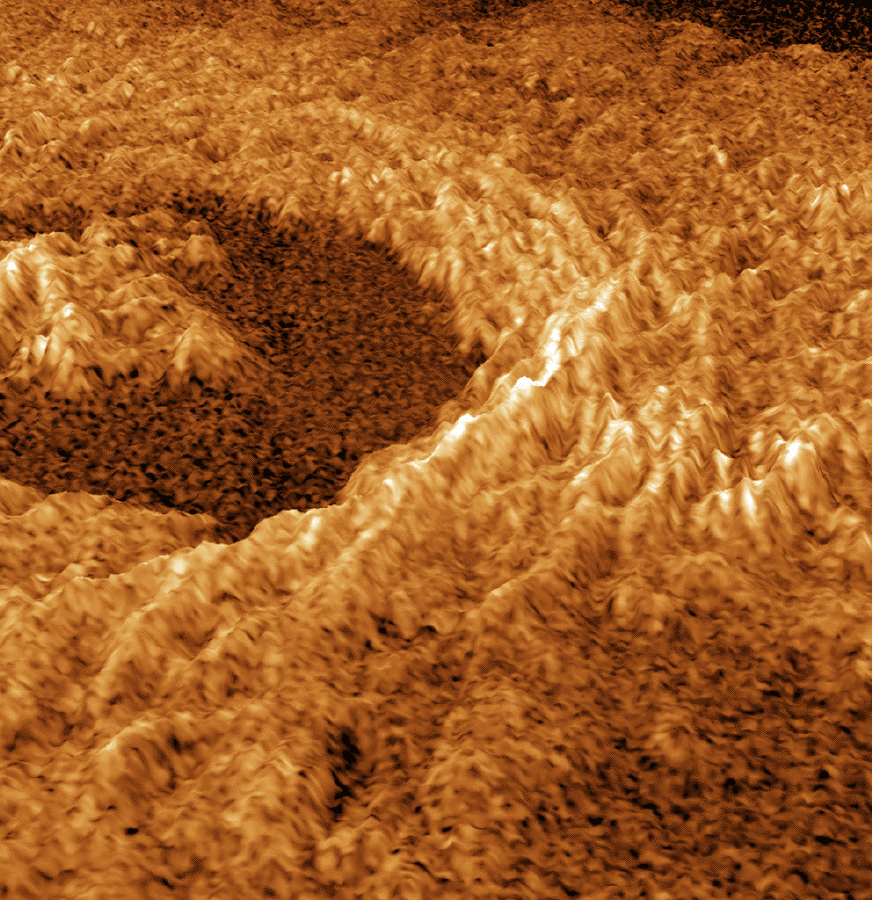
Caption: A 3-d model of Venus impact crater Golubkina based Magellan radar mapping.
The color is false, of course, but was chosen to emphasize structural detail and simulate the colors seen on the surface by the Soviet Venera landers.
The vertical scale may be stretched to emphasize the features.
This seems to be a typical impact crater with central peak, flatish floor, and slumping rim walls.
Credit/Permission: NASA, before or circa 2003 / Public domain.
Download site: Views of the Solar System by Calvin J. Hamilton. CJH states the image is Public domain.
Image link: Itself.
The relatively small number of craters on Venus tell us that the surface has been re-surfaced and it can be estimated from the crater counts that the current surface is on average somewhere in the range of 500--800 Myr old (HI-177). (The time scales vary with reference source.)
The whole surface is probably younger than 1 Gyr.
The implied renewal rate does seem to be about five times slower than for the Earth on average (CW-34).
On the other hand the Earth has some very old patches that Venus may lack (HI-177). (But how do we know this????.)
More cratering and slower renewal than Earth can at least partially be accounted for by the LACK of water erosion.
The only things that can erase craters are volcanic lava flows and ash deposition and small amounts of fold-mountain construction and wind erosion.
-
Cratering to erase craters is a slow process after the heavy bombardment
and probably negligible on a planet where the surface is continually
being renewed.
An interesting point about Venusian craters are that there are none smaller than about 3 km in diameter (Se-473).
-
Question: Why are there no small craters?
- The small impactors burn up or break up in the heavy atmosphere.
- The small craters are selectively erased by volcanic action. Volcanoes prefer forming near small craters.
Answer 1 is right.Of course, there is NO micrometeoritic erosion on Venus pulverizing the surface to regolith as on the Moon and Mercury.
- Other Geologic Processes on Venus:
What are the forces of continuing geologic change besides cratering?
There is wind erosion as mentioned above, but this is slow compared to the absent water erosion.
So we come to VOLCANISM driven by primordial-radiogenic heat.
Volcanic action creates new lava flows and ash layers that cover old terrain.
Some horizontal crustal movement initiated by lava flooding may created limited fold mountains (Se-471).
Shield volcanoes such as occur on Earth and Mars are present. See the figure below (local link / general link: volcano_shield_cartoon.html) showing a cartoon of a shield volcano.
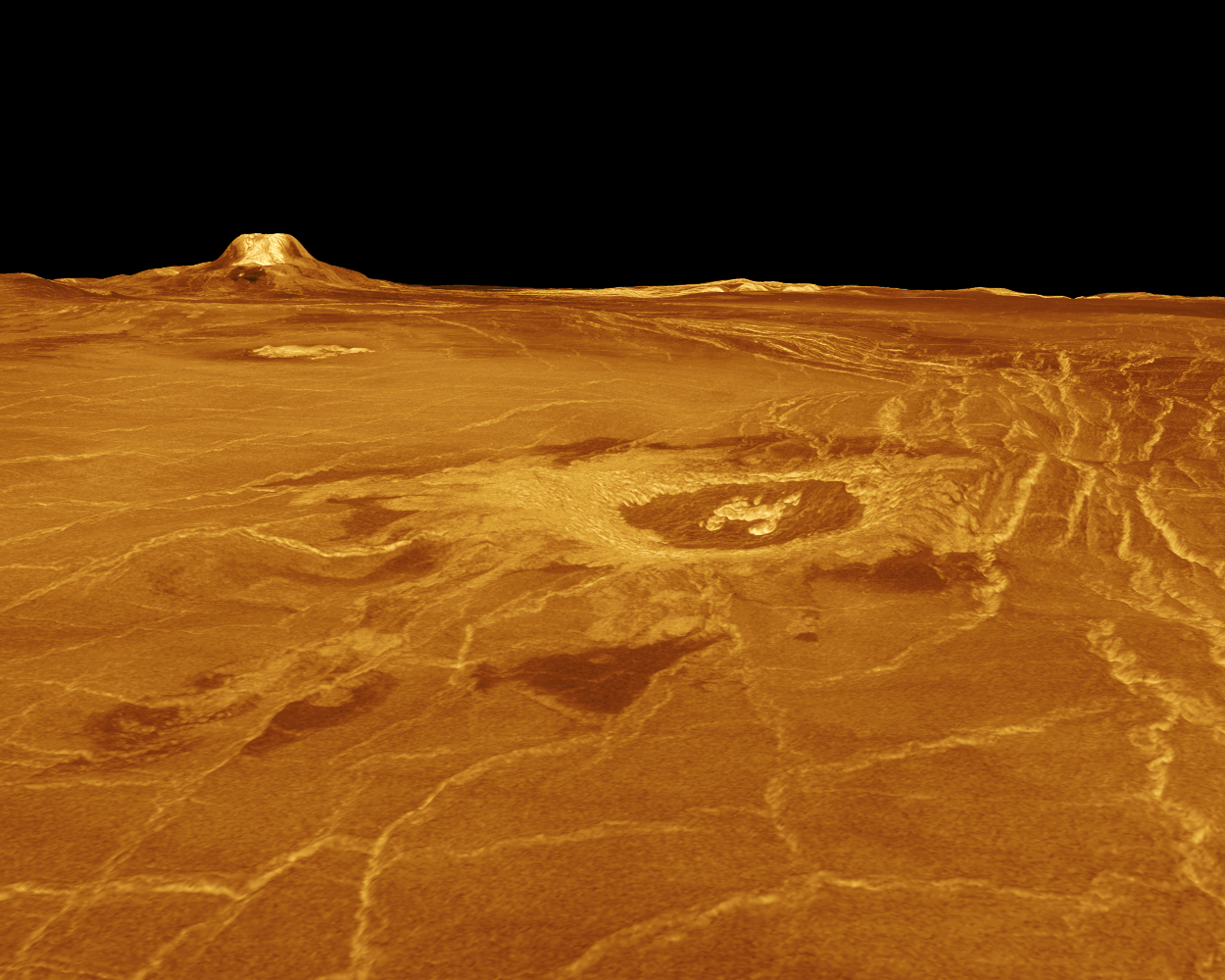
Caption: A model 3-d view of Gula Mons and Crater Cunitz on the western part of Eistla Regio.
Lava flows and faults appear as bright in the image.
Eistla Regio is about at the west end of Aphrodite Terra and south of the east end of southmost reaching part of Ishtar Terra.
-
Eistla is a Norse giantess.
A regio is a large area marked by
reflectivity or color distinctions from adjacent areas,
or a broad geographic region.
The image is based on radar data from the Magellan orbiter The colors are meant to imitate those shown by the Soviet Venera 13 and 14 landers and are used to enhance surface structure.
The elevations have been stretched by a factor 22.5 ??? to enhance visualization ( NASA NSSDC Photo Gallery Venus).
You are looking from an elevation of 0.78 km to the north-east toward Gula Mons which is 1,310 kilometers away.
Gula Mons is a 3 km high volcano: it is a normal shield volcano (Se-473), but the stretching has made it look a bit unnatural???. The height is relative to the Eistla Regio ( NASA NSSDC Photo Gallery Venus).
Gula is a Babylonian earth mother: symbolically a creative force---I just quote the sources.
Impact Crater Cunits is named for Polish mathematician and astronomer Maria Cunitz (1610--1664). It is in the foreground and 215 km from the observer. The crater diameter 48.5 km. It shows the rim and flatish inner floor with a central peak of a typical large impactor crater.
JPL Multimission Image Processing Laboratory produced the image for release at a 1991mar05 JPL news conference.
Credit/Permission: NASA, JPL 1991 / Public domain.
Download site: Views of the Solar System by Calvin J. Hamilton.
Image link: Itself.
One volcanic feature unique or nearly unique to Venus are coronae.
The singular is corona, but this is NOT to be confused with the solar corona.
For an example of a corona, see the figure below.
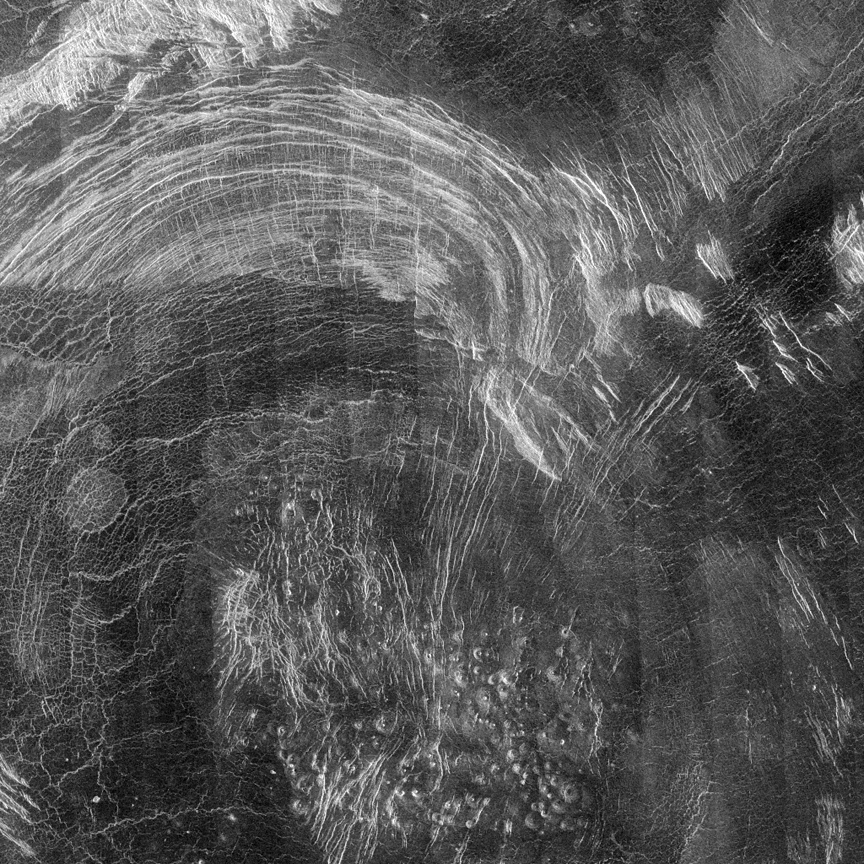
Caption: Boann Corona on Venus with multidinous shield volcanoes from Magellan radar mapping.
There are also about 360 roughly circular domes or depressions called coronae surrounded by circular and radial fractures and located with some volcanoes (HI-176).
Some are flooded by lava.
These features are typically 200 to 400 km in diameter. They may also represent extreme hotspot volcanism where there is a rising mantle plume of magma.
Upwelling lava would create dome which later can subside to create a depression.
Obvious coronae are NOT found on any other Solar System body.
-
The Tharsis region
on Mars may be
a corona.
Uranus's moon Miranda may have coronae of a sort that are based on ice geology rather than rock geology.
Credit/Permission: NASA before or circa 2003 / Public domain.
Download site: NASA: Venus - Magellan: Shield volcanoes in Boann Corona,Venus.
Image link: Itself.
There are many other geological features on Venus (such as pancake domes), but we won't consider them here.
The locations of volcanoes, coronae, terras, etc. are probably random and determined by the random initial conditions, plus gigayears of continuous geological evolution.
One odd last thing to remark is that Venus has no measurable GLOBAL MAGNETIC FIELD.
But Venus really should have a molten iron core like the Earth.
Maybe the slow rotation of Venus is NOT sufficient to generate a dynamo effect (Se-476).
It built up from protoplanets and planetesimal.
It was hot from formation and radioactivity.
It CHEMICALLLY DIFFERENTIATED.
No GIANT IMPACTOR created a moon, but one may have given Venus it's unusual rotation characteristics as discussed above.
Venus did suffer the HEAVY BOMBARDMENT, but continuing geological activity has erased the EARLY CRATERING just as on Earth.
Venus is almost the same size as the Earth and very probably has the same composition of refractories and radioactive elements.
Thus, its primordial-radiogenic heat geology (see also Wikipedia: Earth's internal heat budget: Radiogenic heat: Primordial heat) should continue to the present.
Venus like the Moon and Mercury and probably the Earth, had lava flooding of huge basins.
And Venus still has lava plains---the gently rolly lowlands that cover 60 % of the surface (HI-174,175).
But those lava plains are NOT the original lava plains.
-
There will be continued geological activity on Venus, but probably
NOT a lot
of qualitative change over the next few gigayears???.
Then Venus will get vaporized in the post-main-sequence-phase Sun in ∼ 5 Gyr (see Wikipedia: Sun: After core hydrogen exhaustion).
The two figures below (local link / general link: sun_evolution.html; local link / general link: sun_red_giant.html) show what happens to the Sun As Time Goes By (1931).
Form groups of 2 or 3---NOT more---and tackle
Homework 13
problems 14--17 on Venusian geology,
the Venusian magnetic field,
the fate of
Venus.
Discuss each problem and come to a group answer.
Let's work for 5 or so minutes.
The winners get chocolates.
See Solutions 13.
End group activity period or
End group activity period or
End group activity period.
Group Activity: